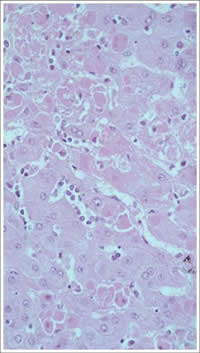Novel Arenavirus Causes Mystery Illness in Zambia and South Africa
Posted October 17, 2008 by Ali S. Khan

Immunohistochemistry stain of the liver from a fatal case of Lassa Fever.
An active, young Zambian safari guide fell ill last month with an unexplained illness that rapidly progressed to her death after medical evacuation to South Africa. Three additional people who had close contact with her or her body fluids, a paramedic, a nurse and a hospital worker, also shortly became ill -- and despite all medical efforts, have also died. A fifth case, also a nurse, is currently hospitalized and receiving Ribavirin treatment. CDC’s unexplained death and severe illness group has supported the Ministry of Health and South African scientists of the National Institute for Communicable Diseases (NICD) to identify a novel arenavirus as the cause of this medical mystery.
Sick persons identified in this cluster first became ill with fever, headache, sore throat and later diarrhea – unspecific symptoms that could easily be mistaken early for influenza this time of year. But their illnesses took a turn for the worse, leading to rapid multi-organ failure and death. Initial blood samples taken from the paramedic in late September tested negative at the Special Pathogens Unit in Johannesburg for viral hemorrhagic fevers (VHFs), Rickettsia, and Leptospira infection. CDC received tissue and serum samples taken postmortem from the paramedic and nurse who cared for the safari guide last week for additional testing. Staining of the tissue samples by CDC’s Chief Pathologist, Dr. Sherif Zaki, indicate that the illness in these two individuals was caused by a new virus similar to the one that causes Lassa Fever, a member of the arenavirus family, which is spread from infected Muridae rodents to humans when we ingest, inhale, or bring broken skin into contact with their excrement. Word from Dr. Paweska, of NICD, in Johannesburg on Friday confirmed this evidence, as the special pathogens team there has isolated the virus from liver samples. The identification of a new virus causing severe illness in humans with efficient person-to-person transmission is a reminder of the continual microbial threat and the need for a new strategy focusing on prevention through integration of our efforts in the animal, human, and environmental domains. Teams in South Africa and the United States continue to collaborate to learn more about the virus and the disease it causes.
Learn more about South Africa’s National Institute for Communicable Diseases.
Comments
No comments posted.
Disclaimer: The content of Public Health Matters expresses the opinions of its authors and does not necessarily represent the views of the Centers for Disease Control and Prevention.
- Page last reviewed: July 3, 2008
- Page last updated: October 10, 2008
- Content source: National Center for Zoonotic, Vector-Borne, and Enteric Diseases
Contact Us:
- Centers for Disease Control and Prevention
1600 Clifton Rd
Atlanta, GA 30333 - 800-CDC-INFO
(800-232-4636)
TTY: (888) 232-6348
24 Hours/Every Day - cdcinfo@cdc.gov

